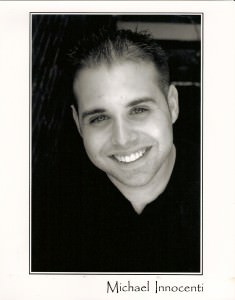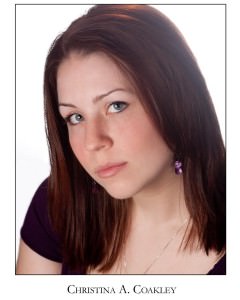Christina A. Coakley and Michael Innocenti are putting on the finishing touches on their new production of Kander and Ebb’s Cabaret at The Keegan Theatre. The show begins performances on Saturday. I had a chance to ask both of them about co-directing Cabaret.
Cate: What about directing this production of Cabaret appealed to you?

Since you are co-directing, how does that work? How are you enjoying working together? Do you find it easier to work together on the other side of the table?
There are moments of great joy in discovering that our combined ideas work in execution. Then there are moments when you think, “I wonder what would happen if I put this pillow over your face and hold it there.” We are both very passionate and opinionated people that feed off each other’s creativity. Being able to go home and have an open debate about aspects of the show is a benefit. You don’t have to worry about a working relationship falling apart if there are tense moments or disagreements, because the love you have for the other allows you to compromise.
We have been working together at Keegan for more than five years, so we know that no matter if Michael is in a show that Christina is directing or, as in this case, working together side by side, we will be there to support each other both professionally and personally. Fortunately, we have the ability to seek out advice from other Keegan couples who have already experienced the challenges of working together.
In directing the show, did you find parallels between what was happening in the US in the 60s when Harold Prince directed Cabaret and certain current events now?
One parallel between the two eras is the prolonged state of military combat. While the population railed against warfare and started a cultural revolution during the 1960s, it seems today the country has become wholly apathetic to the conflict. Though these are two entirely different circumstances, our society’s listlessness is akin to the attitude of the Weimar Republic before the Third Reich. In Cabaret, we are able to see the worst case scenario of the consequences of inaction.
Cabaret deals with some fairly heavy themes, and in 1966 it was a real departure for the American Musical in that regard. How do you balance the fun of the androgynous sexuality present in the Kit Kat Klub with the heavier themes like Sally Bowles’ revelation in the song “Cabaret”?
As in every production at Keegan, we simply try to tell the story and make these characters and situations as real and as human as possible. We’ve allowed some flexibility to that policy for the musical numbers because the hyper-reality of the cabaret songs strengthens and clarifies the book scenes. Since Cabaret was one of the first true concept musicals, we wanted to present something that is abstract for a purpose, and not just for the sake of being abstract. Our goal was for the audience to be just as engrossed in the book scenes as they are in the production numbers, because both are essential to the story.
What are some of the challenges you have had as a creative team while working on this project?
As with most large shows that Keegan produces, the primary challenge involves finding the right scale in which to present the piece. There are several different locations and many costume demands – many details, large and small, that need strong execution and problem-solving to put the artists involved in the best position to tell this story in this space. The Cabaret artistic team has been terrific at collaborating to find creative solutions and achieve the proper scope needed for the show.
What has been the most rewarding aspect of this creative process?
By far, the most rewarding aspect has been working with this cast and creative team. Each person brings a tremendous passion, talent and focus to the show.
Without giving too much away, is there anything new that your audience can expect in this production that might surprise them?
We hope there are many new things to enjoy in this production of Cabaret – some subtle, some more noticeable. For one, we think audiences will appreciate the interesting, fresh choices that have been made in terms of the choreography. Rachel has done a beautiful job of showcasing the unique talents of our cast and putting her own stamp on these familiar songs.
Introduce us to your cast and their roles. What do they bring to their performances that make the show a ‘Must See’?
Keegan company member Bradley Foster Smith is playing the role of Clifford Bradshaw. Cliff is one of the more deceptively difficult parts, as there is a tendency for him to be played as an “aw, shucks” American stereotype. Brad, coming from a background of mainly straight plays, immediately brings the proper weight and actor’s instinct that makes the character his own. An additional benefit is that Brad is a very musical person, often serving as one of Keegan’s primary late-night entertainers, playing guitar (or accordion) and singing his unique catalog of original songs and popular covers.
Paul Scanlan plays the role of the Emcee. He was last seen at Keegan in our production of Spring Awakening. As was evident in that production, Paul possesses an intensity and energy that makes his Emcee particularly dynamic and intriguing. Paul’s voice is also a tremendous instrument — his lyric and musical phrasing is just outrageously good.
Taking on the role of Sally is Maria Rizzo. Maria has the perfect combination of talents and qualities to make her Sally a larger-than-life tragic figure. It is difficult to take your eyes off this ‘train wreck waiting to happen.’ Maria has been able to capture Sally’s childish, playful qualities while at the same time revealing the cracks beneath the façade.
These three are joined by Keegan Company veterans Jane Petkofsky and Stan Shulman as Fraulein Schneider and Herr Schultz. One of the benefits of having company members working together is that there is an already established respect and a chemistry that strengthens the relationship between these two great characters.
The cast is rounded out by a group of exceptional musical theatre performers from the area. Every last one of them brings extraordinary talent to this show, and we are so grateful for their dedication and hard work.
Introduce us to the designers of the team and how their design has captured your vision for this production of Cabaret.
We’re thrilled to introduce our choreographer Rachel Leigh Dolan to Keegan audiences. Rachel has been a dream to work with, bringing her own fresh vision to our production. There was literally nothing that we could throw out at her that she could not bring to life with these amazing dancers. She has been enormously successful in taking our concept and sharing it through the choreography.

The remaining staff are veterans of the Keegan Theatre, having worked on a multitude of productions. Craig Miller (Hair and Make-up Designer), Jake Null (Sound Designer/Engineer), and Carol Baker (Set Dresser and Properties Designer) have provided wonderful designs for Keegan in the past and this production is no exception. They’ve been critical members of this team from start to finish.
How many musicians are in the show and who is the Music Director?
We are fortunate to have nine wonderful musicians playing the score under the direction of John-Michael d’Haviland. As with Rachel, working with John-Michael has been a blissful experience, and we are grateful for his talents. He is able to interpret the score in a way that fits our vision and articulate these needs to our musicians.
Why do you think Kander and Ebb’s score is still so effective? What song is your favorite?
While the Cabaret score certainly has its share of “hummable” tunes, its timelessness is because of the combined efforts of two men who know the craft of musical theatre writing better than almost anyone. The way the lyrics are carefully laid on top of the notes, the way the harmonies give tension and balance to the melodies, and the progressions of the musical motifs all combine to make a score that illuminates the characters and leaves a powerful impression.
Our favorite song is probably “If You Could See Her.” The melody seems light and carefree upon first listen, especially when coupled with the staging. For audiences unfamiliar with the show, this song seems comical at first – pulling the audience out of the progressively darker storyline for a moment. However, when the Emcee lands that final lyric, the song takes an abrupt about-face that can be really unsettling to experience. This one phrase was so shocking that it was struck from the original Broadway production due to resounding protest. That little bit of history makes the song that much more interesting.
What do you want audiences to take with them after leaving Cabaret?
Every director wants the audience to come out of the show having lived the ideas and themes that have been so painstakingly sculpted. Our primary objective is to tell the story; what each person will take away is entirely personal. We want the show to be a springboard for people to start a conversation and think about how the themes relate to their own lives.

Cabaret plays from January 26th through February 23, 2013 at The Keegan Theatre – 1742 Church Street, NW, in Washington, DC. For tickets, purchase them online.





Good luck to the cast and crew. Rachel,we are so proud of you.Way to go girl. Love Maura and Chuck
Rachel, Enjoy every moment! As Joycela would say”Splendid” . Love Ellen and Peter